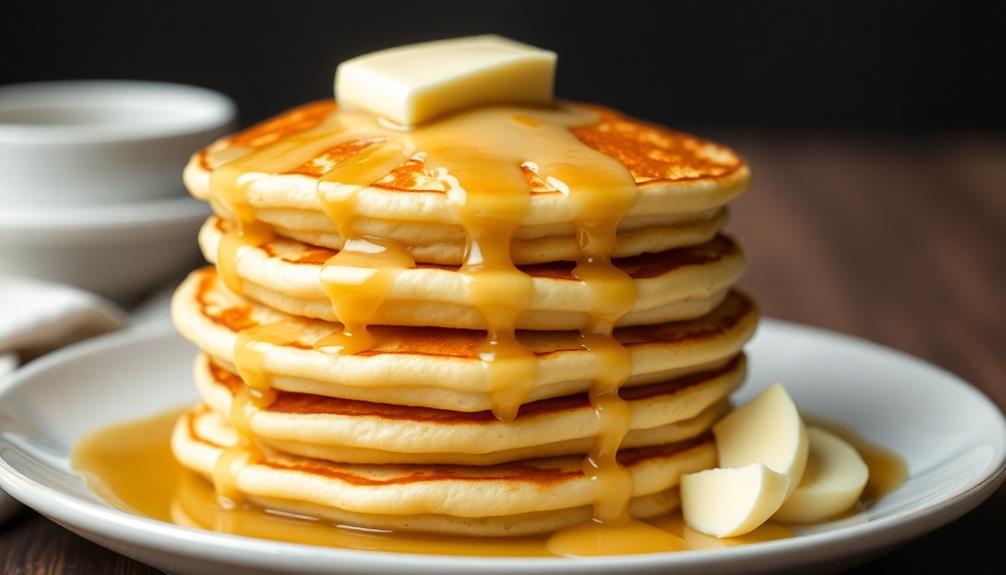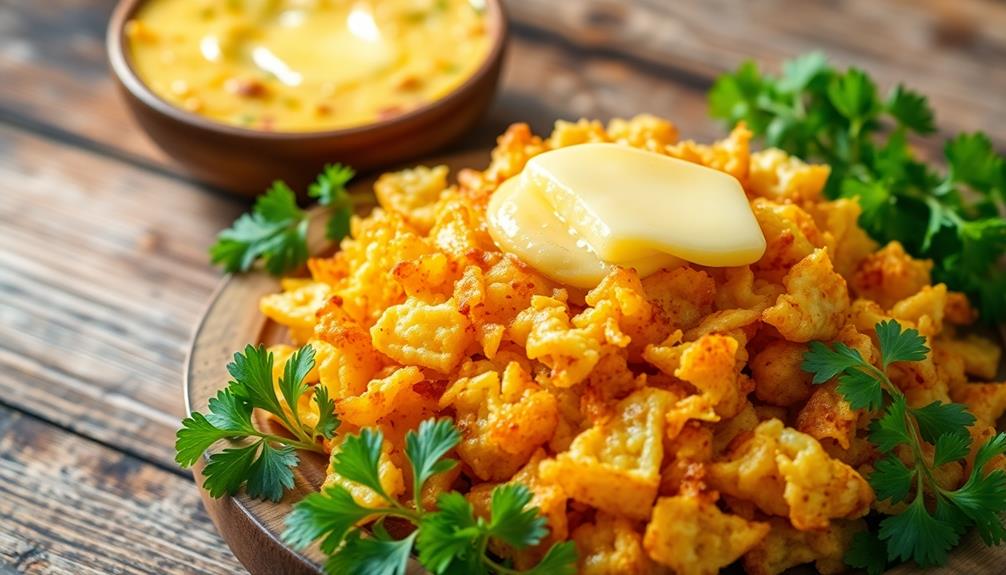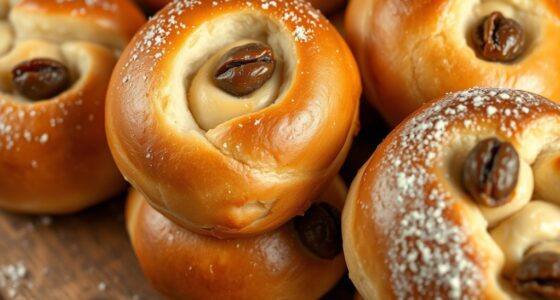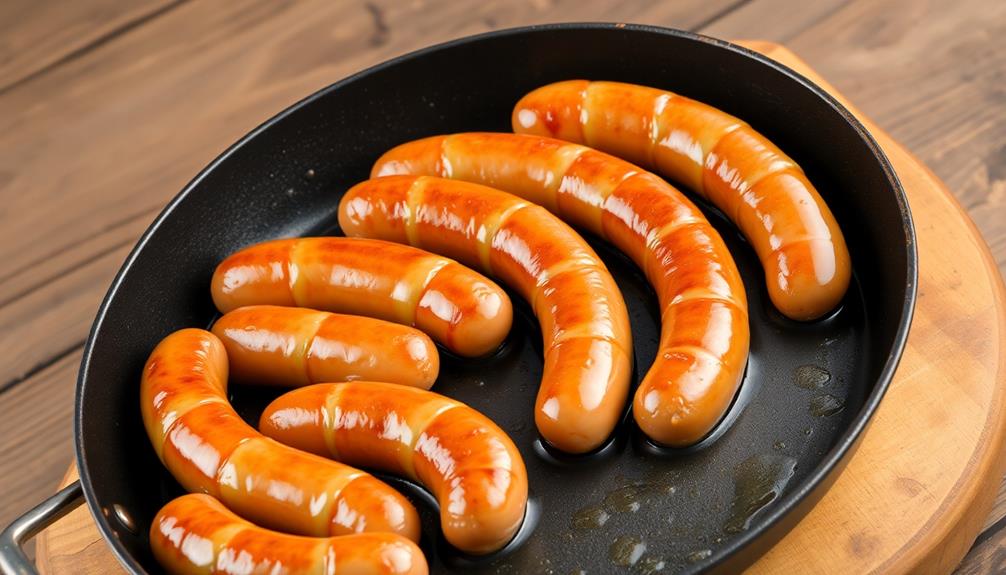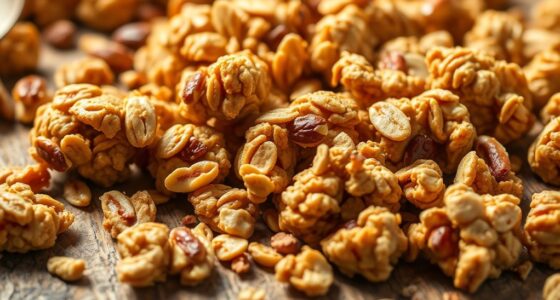Prepare to indulge in a stack of buttermilk pancakes so light and fluffy, you'll feel like you're floating on a cloud of pure delight – all thanks to the secret ingredient: vanilla bean butter that melts into every bite. Tracing back centuries, buttermilk has been a staple in baking, while pancakes can be found as far back as ancient Greece. Today, this classic duo creates a time-honored breakfast tradition, delivering a comforting, tangy flavor and tender texture in each forkful. With easy-to-follow steps and endless topping possibilities, you'll be mastering this beloved dish in no time. Dive in for a taste of breakfast bliss.
Key Takeaways
- Buttermilk pancakes have a rich history, with origins tracing back to ancient Greece and Rome, and a beloved tradition in the American South.
- The recipe is easy to follow, with common ingredients and minimal effort, making it accessible for individual servings and larger groups.
- The cooking process involves sifting dry ingredients, whisking wet ingredients, and gently folding the two together to achieve a light, fluffy texture.
- The unique flavor profile of buttermilk provides a tangy taste and tender texture, and the addition of vanilla bean butter adds richness and creaminess.
- Mastering this classic dish not only satisfies cravings but also contributes to culinary skills, evoking nostalgia and a sense of accomplishment.
History
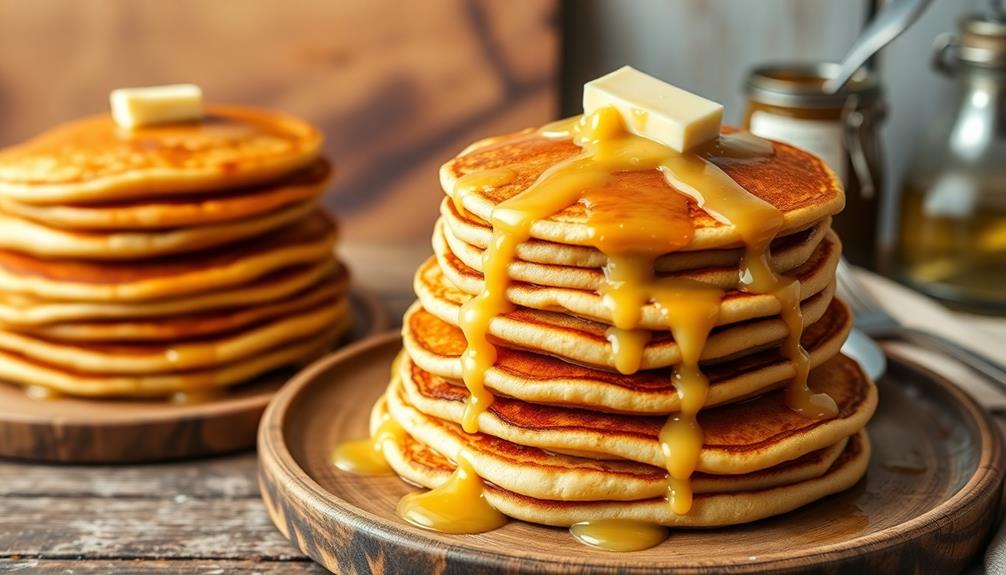
Though the exact origins of buttermilk pancakes are unclear, they've been a staple in many households for generations. Buttermilk, a byproduct of churning butter, has been used in baking for centuries, adding a tangy flavor and tender texture to everything from biscuits to cakes.
Pancakes, on the other hand, can be traced back to ancient Greece and Rome, where they were made from wheat flour, eggs, and milk.
Over time, the combination of buttermilk and pancakes became a beloved breakfast tradition, especially in the American South. Families would gather around the table, eagerly anticipating the stack of fluffy, golden-brown pancakes, topped with sweet maple syrup and maybe a pat of rich, creamy butter.
The ritual of making and eating buttermilk pancakes has become a comforting part of many people's childhoods, evoking memories of cozy mornings and the welcoming aroma of a home-cooked meal.
Recipe
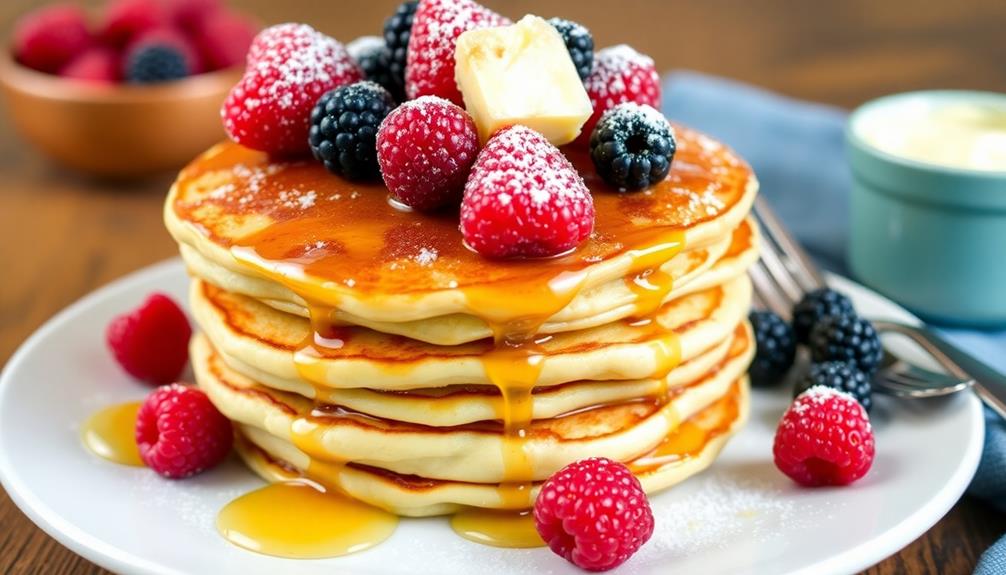
Buttermilk pancakes are a classic breakfast treat that are light, fluffy, and incredibly delicious. The use of buttermilk in the batter gives these pancakes a tangy flavor and tender texture that sets them apart from regular pancakes.
Preparing buttermilk pancakes from scratch is surprisingly easy and well worth the minimal effort required. With just a few simple ingredients and a bit of time, you can create a stack of hot, freshly made pancakes that will delight your taste buds and start your day off right.
Ingredients:
- 1 1/2 cups all-purpose flour
- 3 1/2 teaspoons baking powder
- 1 teaspoon baking soda
- 1 teaspoon salt
- 1 tablespoon white sugar
- 1 1/4 cups buttermilk
- 1 egg
- 2 tablespoons unsalted butter, melted
Instructions:
In a large mixing bowl, whisk together the flour, baking powder, baking soda, salt, and sugar.
In a separate bowl, combine the buttermilk, egg, and melted butter.
Pour the wet ingredients into the dry ingredients and stir just until combined (do not overmix). Let the batter rest for 5 minutes.
Heat a lightly oiled griddle or nonstick skillet over medium heat.
Scoop the batter onto the griddle, using approximately 1/4 cup for each pancake. Cook until bubbles appear on the surface, then flip and cook until golden brown on the other side, about 2-3 minutes per side.
Serve the buttermilk pancakes warm, with your favorite toppings such as maple syrup, fresh berries, or whipped cream. Enjoy!
Cooking Steps
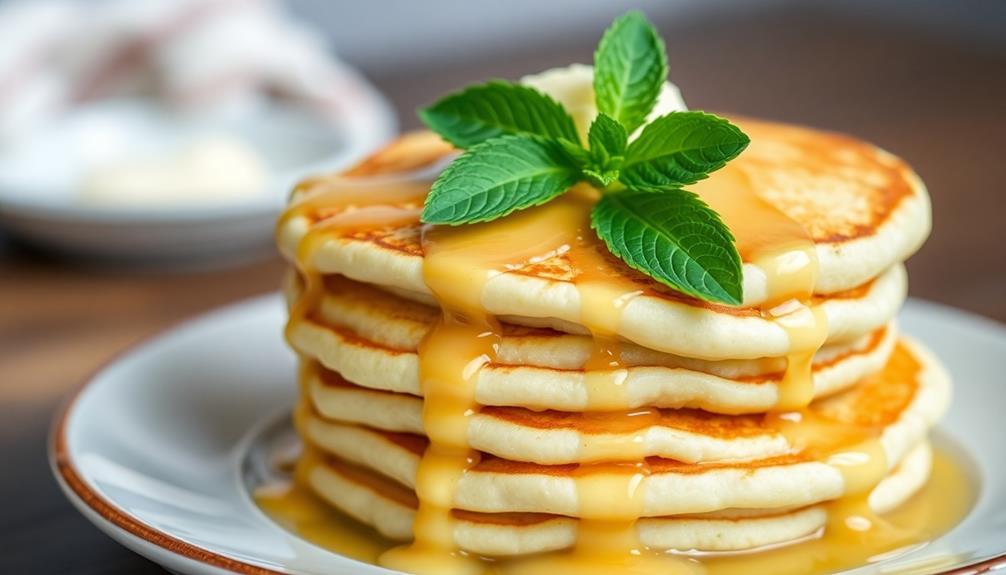
Sift the dry ingredients together to evenly distribute the flour, baking powder, and other powders.
In a separate bowl, whisk the wet ingredients like buttermilk and eggs until well-combined.
Now, gently fold the wet and dry mixtures together, being careful not to overmix.
Preheat your griddle and start cooking those fluffy buttermilk pancakes!
Step 1. Sift Dry Ingredients Together
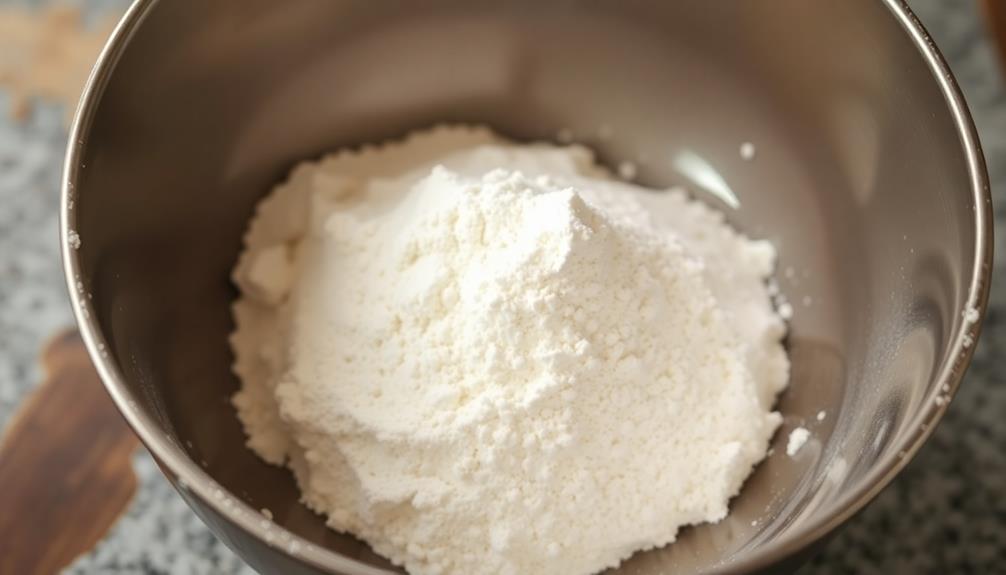
The dry ingredients require a gentle sifting to incorporate air and ensure an even distribution throughout the batter. This simple step creates a light and fluffy texture in your pancakes.
First, gather a fine-mesh sieve and place it over a large mixing bowl. Into the sieve, add the all-purpose flour, baking powder, baking soda, salt, and a pinch of white sugar.
Gently shake the sieve back and forth, allowing the dry ingredients to fall into the bowl below. The sifting motion incorporates tiny pockets of air, giving your pancakes an irresistible lift.
Be sure to sift the ingredients thoroughly, breaking up any small clumps of flour. This ensures the batter mixes together evenly, without any dry pockets.
With the dry ingredients ready, you're one step closer to creating a stack of buttermilk pancakes that are light, tender, and delicious.
The next step is to whisk in the remaining wet ingredients for a smooth, pourable batter.
Step 2. Whisk Wet Ingredients in a Bowl
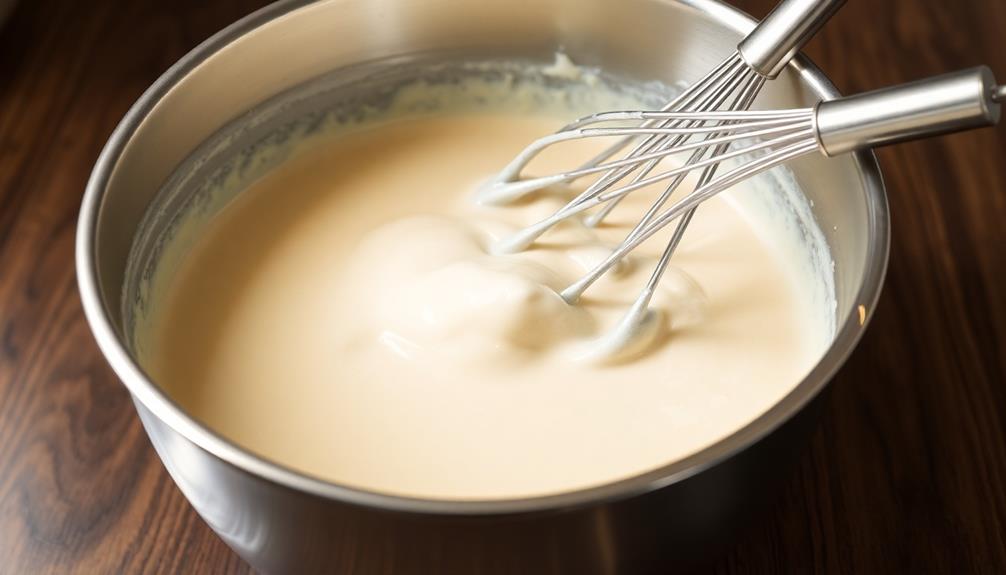
Next, whisk together the buttermilk, egg, and melted butter in a separate bowl. The rich, tangy buttermilk will add a delightful flavor to your pancakes, while the egg helps bind the batter together and the melted butter contributes a lovely, velvety texture.
Whisk these wet ingredients vigorously, ensuring they're fully combined and smooth. You want the batter to have a pourable, yet slightly thick consistency – not too runny, but not too stiff either. This perfect balance will lead to fluffy, evenly cooked pancakes.
As you whisk, imagine the aroma of the vanilla bean butter that will soon top your stack of heavenly buttermilk pancakes. The scent of the vanilla and the slight tang of the buttermilk will have your mouth watering in anticipation.
Keep whisking until the batter is ready to be added to the hot griddle, where it will sizzle and transform into a golden, fluffy delight.
Step 3. Combine Wet and Dry Ingredients
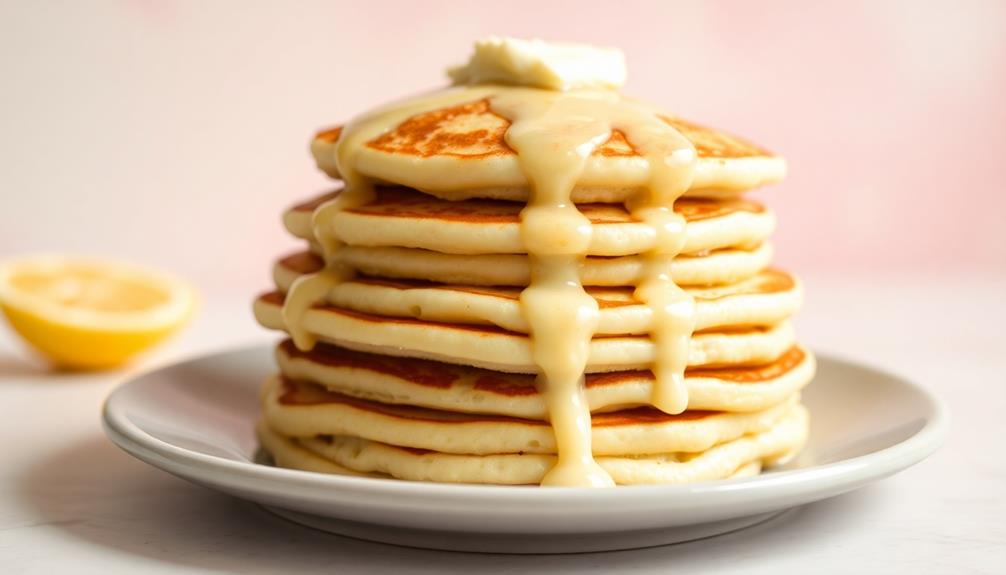
With the wet ingredients whisked and ready, it's time to bring together the dry and wet components of your buttermilk pancake batter.
In a large bowl, combine the all-purpose flour, granulated sugar, baking powder, baking soda, and a pinch of salt. Whisk these dry ingredients together until they're evenly mixed.
Now, pour the whisked buttermilk, melted butter, and vanilla extract into the center of the dry ingredients.
Using a rubber spatula, gently fold the wet ingredients into the dry, taking care not to overmix. The batter should have a slightly lumpy, thick consistency – don't worry about getting it perfectly smooth.
Resist the urge to vigorously stir, as that can result in tough, rubbery pancakes. Instead, fold the batter just until the wet and dry are combined.
With the wet and dry elements united, your pancake base is ready to be scooped and sizzled on the griddle. Get ready for a stack of fluffy, flavor-packed buttermilk pancakes!
Step 4. Gently Fold in Wet and Dry
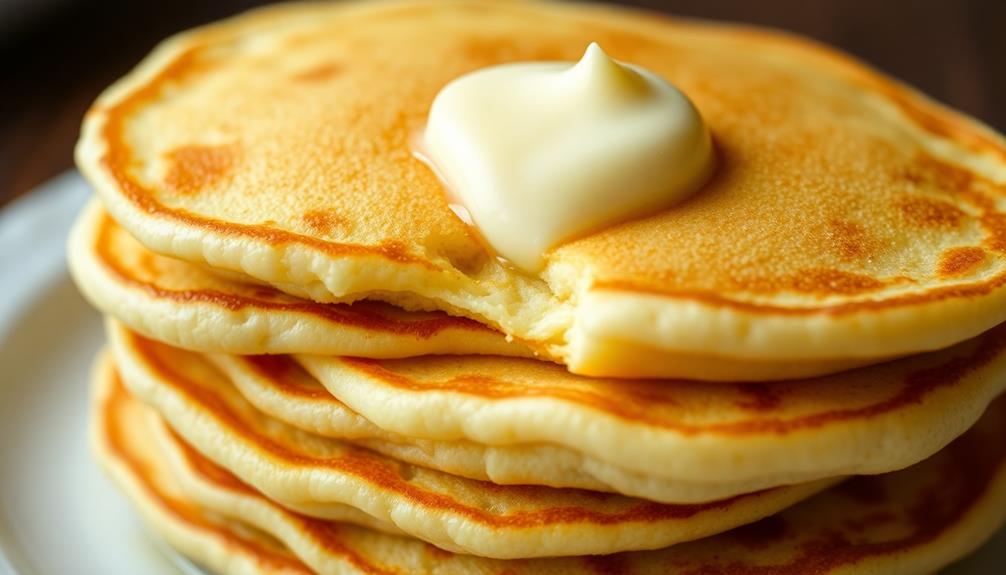
Gentle folding of the wet and dry components is the key to achieving the desired light and tender texture in your buttermilk pancake batter.
Take care not to overmix, as this can result in tough, rubbery pancakes. Using a large rubber spatula, gently fold the wet ingredients into the dry, making sure to incorporate them evenly without deflating the airy mixture.
Imagine a gentle folding motion, almost like you're turning the batter over itself. Avoid stirring or beating, which can develop too much gluten and make the pancakes dense.
The batter should have a few visible pockets of dry ingredients remaining – this is perfect! Overworking the batter is the enemy of fluffy pancakes.
Maintain a light touch, and your efforts will be rewarded with a stack of tender, irresistible buttermilk pancakes.
Step 5. Cook on Preheated Griddle
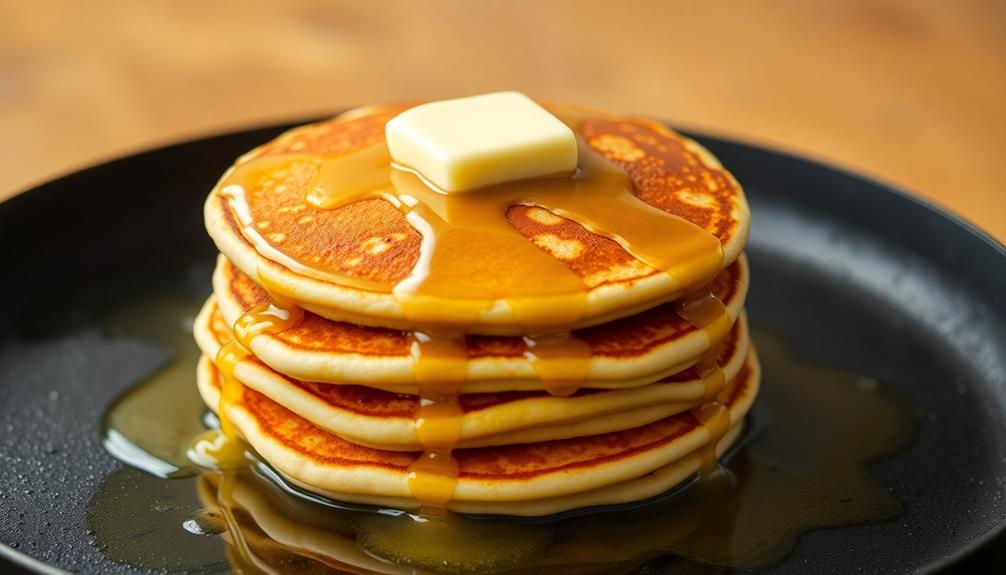
Preheat your griddle or large nonstick skillet over medium heat. You'll know it's ready when a drop of water sizzles and dances across the surface.
Lightly grease the griddle with a small pat of butter or nonstick cooking spray. Using a ladle or measuring cup, pour batter onto the hot surface, forming pancakes about 4 inches wide.
Resist the urge to peek or flip too soon – let those cakes cook for 2-3 minutes until the bottoms are golden brown and the edges are set. Flip them gently with a spatula, being careful not to tear the delicate pancakes.
Cook for another 1-2 minutes on the second side until cooked through. The pancakes are ready when they release easily from the griddle and bounce back lightly when poked.
Repeat with the remaining batter, keeping the cooked pancakes warm in a 200°F oven while you work through the batch. Soon, you'll have a tall stack of perfectly fluffy buttermilk pancakes, ready to serve with your favorite toppings.
Final Thoughts

After following the recipe and enjoying these delicious buttermilk pancakes, you can reflect on the overall experience.
The fluffy texture and tangy flavor of the buttermilk create a stack of heaven that's sure to delight your taste buds. As you savor each bite, the vanilla bean butter melts into the warm pancakes, adding a luxurious creaminess that elevates the dish.
You'll be amazed at how the simple ingredients come together to produce such an indulgent and satisfying breakfast. These buttermilk pancakes are the perfect way to start your day, leaving you feeling satisfied and energized.
The recipe is easy to follow, and the results are consistently amazing. Whether you're cooking for yourself or serving a crowd, these pancakes are sure to impress.
Enjoy the comforting flavors and the sense of accomplishment that comes with mastering this classic breakfast dish.
Frequently Asked Questions
Can I Substitute Regular Milk for Buttermilk?
Yes, you can substitute regular milk for buttermilk in most recipes. However, the flavor and texture won't be quite the same. Buttermilk adds a tangy richness that regular milk can't replicate. Give it a try and see which you prefer!
Is There a Healthier Alternative to the Vanilla Bean Butter?
You can explore healthier alternatives to the vanilla bean butter, such as using mashed avocado, almond butter, or even plain Greek yogurt. These options provide a creamy texture with less saturated fat and added sugars.
Can I Make the Pancake Batter the Night Before?
You can absolutely make the pancake batter the night before. Simply whisk together the dry ingredients, then refrigerate the wet ingredients separately. In the morning, combine the two and cook your pancakes for a quick and easy breakfast.
How Do I Ensure the Pancakes Have a Fluffy Texture?
To ensure fluffy pancakes, use room-temperature ingredients, avoid overmixing the batter, and let it rest before cooking. Separate the egg whites and fold them into the batter just before cooking for an extra light and airy texture.
Can I Freeze the Leftover Pancakes for Later Use?
Yes, you can freeze the leftover pancakes for later use. Just wrap them individually or stack them with parchment paper between each one, then place them in an airtight container or freezer bag. They'll keep for up to 3 months.
